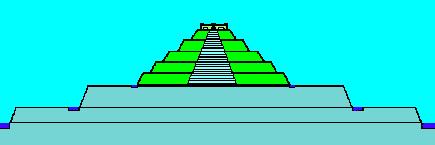ATLANTIS in ANTARCTICA
ATLANTIS IN ANTARCTICA -
According to Plato, Atlantis was destroyed by a natural event about 9,000 years before his time, that is, in coincidence with the end of Pleistocene. It can be assumed, therefore, that the end of Atlantis was strictly related with the events that provoked the end of Wurm glaciation, the mass extinction of the Pleistocene mega fauna and the sudden disappearance of the Magdalenian cultures. In order to understand what really happened, it is necessary to know precisely what the climatic and geographic situation was at that time, and which were the causes that changed it.
Throughout a thorough examination of all available evidence about the last glaciation, the author reaches the conclusion that it was due to a different position of the poles and to a lower tilt. Its end was owed to a sudden shift of the poles, together with an increase of the tilt. This hypothesis has been proposed several times in the past, but so far without a satisfactory physical explanation about the possibility of a very rapid shift of the poles. Such an explanation is provided by the author, together with a mathematical demonstration, starting from the consideration that the oceans, an enormous free liquid surface, are a source of instability for planet Earth, so high that a “kick” provided by the impact of a relatively small celestial body is sufficient to trigger a process, that in a matter of days can produce a permanent shift of the poles. The shift is characterized by wide fluctuations of the sea level (up to several hundred meters), earthquakes, volcanism, a world wide hurricane, with very
strong winds, exceptional rains and floods and permanent climatic variations.
According to this scenario, the geographic situation before the end of Pleistocene was the following: North Pole somewhere around southern Greenland; South Pole at the edge of Antarctica, towards Australia; sea level about 130 meters below the present one. The pacific side of Antarctica was covered by a thick ice-cap, as of today, while the Atlantic side was ice-free and enjoyed a mild climate. An oceanic stream flowed towards South America and Antarctica from South-East Asia, where man had developed means of navigation since 50.000 years ago (Australia was colonised by sea at that time). Rafts could have been carried along that stream to Antarctica, where the different environmental conditions stimulated the start of agriculture and in the end of the first human civilisation, while the rest of the world continued to be Palaeolithic. A sudden shift of the poles, triggered by an asteroid impact (crater of Sithilemenkat, Alaska), put an end to this civilisation and buried its remains under a thick layer of ice, out of reach for archaeologists.
Atlantis, however, had thousands of ships, a good many of which managed to survive the disaster, recovering along the coasts of America, Africa and Asia, where the survivors merged with local populations, giving origin to all ancient civilisations.
This scenario is supported by a large amount of evidence of different nature, from geological to ethnological. In particular there are renaissance maps and medieval planispheres pointing specifically to Antarctica.
(go to the full work)
ARE MEDIEVAL PLANISPHERES REPRESENTING LATE PLEISTOCENE ANTARCTICA? -
Scholars where intrigued by the fact that Antarctica has been
represented on maps produced when its existence was not known yet. But most
intriguing was the fact that apparently those maps represent Antarctica as it
looked like at the end of Pleistocene, with a lower sea level and ice-free
Atlantic shores.
At that time Earth had a peculiar climatic and geographic
situation, of which a possible explanation (independent and quite different
from Hapgood’s) has been proposed by the author, with the hypothesis that the
South Pole was on a different position, precisely at the edge of Antarctica,
towards Australia. If we draw a map of the continent in this situation, taking
the bathymetric of 130 meters as the coastline and orienting the map with the
South Pole at the top, we obtain a representation with some very peculiar
characteristics: an island somewhat circular; a deep fjord on the left,
corresponding to the today’s Mackenzie Bay, with an unmistakable profile; a
wide bay on the right, corresponding to the Ross Sea; at the bottom a wide
internal sea, with a narrow entry, pushing deep inside the continent as far as
the ancient ice-cap. The Peninsula was separated from the main continent by a
narrow channel.
We immediately realize that this representation is
strikingly similar to the world as it was described by ancient mythologies: a
large island, almost circular, surrounded by the “river Ocean”, which flowed
around it. This view was replaced by the Ptolemaic geography during classic
times, but it was resumed in the Medium Age, with the so called T planispheres,
all oriented with the north pole on the left.
If we compare the map of late Pleistocene Antarctica
with the medieval planispheres, we find an undeniable resemblance and sometimes
an absolute identity of shapes, proportions and orientation. Same
characteristics can be recognized on Mercator and Finaeus maps, where
Antarctica is enlarged to reach the tip of South America and the Peninsula is merged into it.
POSTER ATLANTIS in ANTARCTICA -
According to Plato,
Atlantis was destroyed by a natural event about 9,000 years before his time,
that is, in coincidence with the end of Pleistocene. It can be assumed,
therefore, that the destruction of Atlantis was strictly related with the
events that provoked the end of Würm glaciation, the mass extinction of the
Pleistocene megafauna and the sudden disappearance of the Magdalenian
cultures. In order to understand what really happened, it is necessary to
know precisely what the climatic and geographic situation was at that time,
and which were the causes that changed it
(go to the full work)
POSTER OF MEDIEVAL PLANISPHERES -
There are hints suggesting the existence of an unknown civilisation from which all the ancient civilisation have derived. Between them most notable are common architectural conceptions, like the pyramids, similar mythologies with the common belief about a universal flood and a long list of other strange facts that seem to find a satisfactory explanation only on this perspective. Some of them point decisively to Antarctica as the site of this civilisation, whatever was its name.
(go to the full work)
MOUNT MERU
THE HOLY MOUNTAIN OF ATLANTIS
NAVEL OF THE WORLD -
The Mountain-Temple is the most grandiose, but also the most widely-diffused form of ancient religious architecture. This type of structure is to be found all over the world, virtually unchanged, except, obviously, for widely differing styles and techniques peculiar to each race of people. Hundreds of stepped pyramids raise their massive structures from the plains of Mexico and in the United States, Honduras, Guatemala, Perù , Chile, Mesopotamia and throughout Africa and India, as well as Indonesia, Indochina, China and Europe itself. They are to be found even in Polynesia.
It is evident that all the Mountain-Temples, in whatever part of the world they exist, were inspired by a unique model, which couldn’t be none other than the sacred mount of Atlantis, the political and religious heart of the world of that time, being the royal palace and the temple of Poseidon.
(go to the full work)

Atlantis in Antarctica


Are medieval planisheres representing late pleistocene Antarctica?

Poster of Atlantis in Antarctica



Poster of medieval planispheres

Mount Meru the holy mountain of Atlantis navel of the world
- Torna a: "home"
- Acquista un libro

